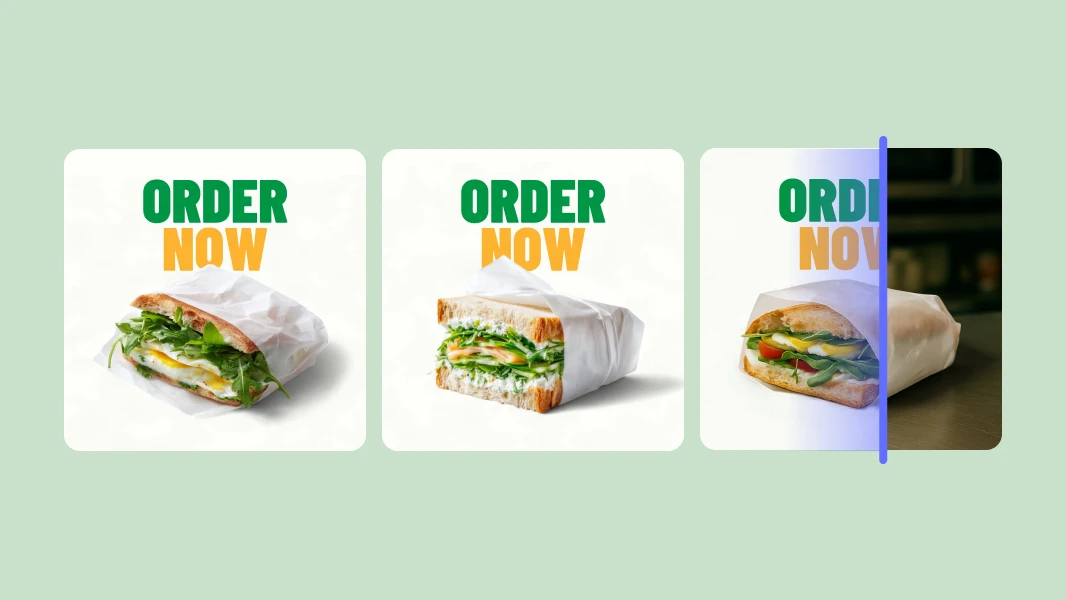Advantages of e-commerce automation in visuals
Photography is an integral part of e-commerce today. This is because sellers, resellers, and vendors along with e-commerce marketplace owners and professionals need to take quality photos of their products and post them on e-commerce websites for their customers to see.
Sellers/resellers and vendors particularly like to showcase photos of their product listings on e-commerce marketplace websites such as Amazon.com or Etsy. To do this, they need to dedicate valuable time and resources to regularly taking, editing, and uploading their product listing photos. This is where artificial intelligence (AI) steps in.
With the use of AI product photography, sellers, resellers, and vendors along with marketplace owners and professionals can quickly and easily generate, edit, and enhance product listing images. One particular form of AI product photography that allows individuals to quickly and easily generate high quality product listing images with an Image Editing API.
What are common types of e-commerce automations?
E-commerce automation encompasses various processes to streamline online retail operations. Common types include:
Order fulfillment automation: Streamlining order processing, inventory management, and shipping to enhance efficiency.
Customer service automation: Automating responses to common inquiries, improving response times, and enhancing customer satisfaction.
Marketing automation: Implementing automated email campaigns, personalized recommendations, and targeted promotions to drive sales.
In this article, we will focus on the optimization of product images, a critical aspect of e-commerce automation, to enhance customer engagement and boost conversion rates. Additionally, we'll explore how leveraging AI in image processing can further streamline e-commerce workflows, ensuring consistent, high-quality visuals across platforms and driving increased sales.
The impact of AI on product photography workflow
Without the use of AI for product photography workflow, some e-commerce marketplaces would have to hire professional photographers to take their company product listing photos. These professional photographers often require expensive staging and long shooting periods followed by long and inefficient photo post-production processes.
Thus, while e-commerce marketplaces may receive decent quality product listing photos from professional photographers, the time spent to get those photos makes hiring professional photographers for product listing photos not worth it. This is especially true when you consider the thousands of products that popular e-commerce marketplaces need to create product listing photos for each day for inventory management - that's a lot of repetitive tasks.
The shift towards quality in e-commerce photography
In fact, the focus of e-commerce marketplaces was previously always on quantity of product listings rather than quality. This is partly due to the “long-tail theory” in the e-commerce industry. The long-tail theory states that most sales come from selling smaller groupings of specialized products to a high number of customers rather than selling a reduced number of high volume, best-selling products to particular types of customers.
Overtime, the long-tail theory led to the saturation of e-commerce marketplaces, as sellers, the marketing team and vendors began to showcase their product listings to a wide range of customers across multiple e-commerce platforms. Therefore, to differentiate oneself from all the other product listing competitors, the quality of product listings and product listing photos started to become much more important.
Fortunately, due to AI, sellers and vendors can now quickly and easily create a high volume of professional-grade photography for product listing photos which can also help with customer loyalty. Seing high quality images ensures trust and can increase conversions. Also due to AI, e-commerce companies can now leverage AI-powered APIs to process images more efficiently and provide image consistency in real time.
How can you use AI product photography for post-production?
Before the use of AI for photo editing, the post-production photography workflow when preparing product listing photos was long and inefficient. For example, post-production of product listing photos previously required lengthy photo retouching with complex software that required training or previous technical knowledge to use.
Now, with AI product photography, e-commerce marketplaces can quickly and easily do things like remove the background in photos - to avoid manual efforts. Also, due to how easy and intuitive AI product photography is to use, e-commerce marketplaces no longer have to outsource as much help for post-production of product listings. Therefore, AI product photography helps e-commerce marketplaces save money on product listings photos and their post-production processes.
Why is AI workflow automation for post-production of product listing photos important?
AI workflow automation is important because time is money in a business. Therefore, AI workflow automation saves marketplace owners and professionals time and money by quickening the post-production process for product listing photos.
In addition, the more time that’s spent on post-production workflow for product listing photos, the less time that those finished product listing photos can be out driving sales. Therefore, to get the most sales out of your product listing photos, it’s important to streamline post-production with the use of AI workflow automation.
Benefits of AI product photography for e-commerce automation
There are many benefits to using AI product photography for e-commerce automation and business processes. The key benefits of AI product photography for e-commerce automation include the following:
Saves time
When it comes to product listings for e-commerce marketplaces, AI product photography technology reduces time to market - meaning that marketplaces can now list products faster and increase sales. This, in turn, leads to scaling the number of images that marketplaces can add that provides an authentic view of the sale products without compromising quality. To save yourself time the maximum amount of time as a marketplace owner, when removing the background in photos or cropping or resizing photos, make use of Photoroom API and shift your focus and time to more value adding tactics.
Consistency
One recurring challenge that e-commerce marketplace owners and professionals often face is the difficulty to maintain image consistency across brands of product listing photos from sellers and vendors. Fortunately, with the precision of AI photo editing tools such as the Photoroom API, maintaining image consistency has never been easier.
Accuracy
Non-AI forms of product photography often struggle to maintain accuracy when it comes to editing and enhancing product listing photos at a large scale. With the precision of AI-powered photo editing tools though, individuals can accurately edit and enhance their photos anytime.
Consistency + accuracy = customer loyalty
Automated image processes and consistent visual presentation play a pivotal role in fostering customer loyalty and satisfaction within e-commerce platforms. By employing image automation tools like AI product photography, e-commerce businesses can ensure a seamless and standardized display of their products across their online storefronts. Consistency in product images instills trust and confidence in customers, as they can rely on accurate depictions of items they intend to purchase. This consistency not only improves the overall aesthetic appeal of the platform but also contributes to a sense of professionalism and reliability, ultimately leading to increased customer satisfaction and loyalty. When customers consistently encounter high-quality, well-presented images, they are more likely to trust the brand, make repeat purchases, and recommend the platform to others, thus foster growth.
Marketplace workflows for preparing external product listing photos
There are various forms of workflow that e-commerce businesses and professionals use to prepare external product listing images from sellers, resellers, and vendors. Each of these forms of workflow has its benefits and inefficiencies. Some of the more common workflows that e-commerce marketplaces use to prepare external product listing photos include the following:
1. Sellers or resellers upload edited images of their product listings in a specified format
In this workflow process, sellers and resellers upload edited photos of their own products to e-commerce marketplace websites in a specified format required by the marketplace. For sellers who are processing lower volumes, they can probably use a photo editing tool, however, when the numbers start going into hundreds of images per day, they should consider automating this.
Benefits
The benefit of this product photography workflow is that marketplace owners and professionals don’t have to waste time uploading or editing the photos of product listings by external sellers and resellers.
Inefficiencies
The inefficiency in this workflow is that, even with the product listing photos being uploaded in specified formats, marketplace owners can’t ensure that the product listing photos uploaded by external sellers and resellers are of high quality.
2. Sellers/vendors manually edit and upload product listing images
Benefits
The benefit of having sellers and vendors upload their own product listing photos to e-commerce marketplace websites is that marketplace owners and professionals don’t have to waste time uploading external product listing photos themselves.
Inefficiencies
An inefficiency of this workflow is that marketplace owners and professionals may struggle to manually edit external product photos in a way that makes each individual seller or vendor’s photos consistently have the same look and feel. This could be an issue for the brands of certain sellers/resellers and vendors.
Another inefficiency of this workflow is that for marketplaces who moderate their seller images, it’s a pain point to have to do that manually given the high volume of photos, time required, and costs.
3. Sellers/Vendors outsource their product listing images editing and uploading
Benefits
The benefit of this workflow is that marketplace owners and professionals don’t have to waste time uploading or editing external product listing photos.
Inefficiencies
The inefficiency in this product photography workflow is that marketplace owners must now spend time and money hiring outsourced professionals on time-consuming task and manual processes that involce photo editing.
4. Sellers/vendors use a Background Remover tool built in-house
Benefits
The benefit of e-commerce automations is that marketplace owners and professionals don’t have to spend time uploading external product listing photos on their marketplace websites. This workflow also allows marketplace owners to not have to spend time and money hiring outsourced professionals to upload or edit external product listing photos. This is because marketplace owners and professionals can quickly and easily edit the external product listing photos themselves with Background Remover APIs that their marketplaces own.
In addition, building one’s own background remover in-house with open source is a cost-effective process, as it ranges from costing $0.003 to $0.01 per image for central processing unit (CPU) usage. This is important to recognize because many e-commerce companies prioritize cost-management in their decision making process.
Another benefit of this workflow is that it provides a great experience to sellers, resellers, and vendors. This is especially true for sellers and vendors with higher image volumes to generate high quality images that can sell their wares.
Furthermore, with the help of AI in the form of Background Remover APIs, marketplace owners can rest assured that external product listing photos will get edited properly and in a visually appealing manner. This is because most Background Remover APIs are innovative and intuitive. Therefore, these API tools make it easy to edit high quality images. The best example of e-commerce automation is Photoroom's intuitive Background Remover API.
Inefficiencies
Developing and maintaining an in-house background remover API for any online business demands a substantial team effort and ongoing refinement processes. While the quality of output may not necessarily be inferior, it necessitates continuous efforts to uphold and enhance standards, potentially requiring additional manual edits after API processing.
5. Sellers/Vendors purchase a photo editing license or background remover API to edit the product listing images
Benefits
The benefit of this workflow is that, once again, marketplace owners and professionals don’t have to spend time uploading external product listing photos on their marketplace websites. Marketplace owners also don’t have to spend time and money hiring outsourced professionals to upload or edit external product listing photos.
In addition, if marketplace owners purchase quality APIs to help them edit external product listing photos, they can rest assured that the photos will get uploaded and edited properly and in a visually appealing manner and according to brand guidelines.
Another benefit of this workflow is that it provides a great experience to sellers, resellers, and vendors. This is especially true for sellers and vendors with higher image volumes to generate high quality images that can sell their wares.
Inefficiencies
One potential inefficiency of this workflow could be the reliance on external tools or APIs for editing product listing images. While these tools can certainly streamline the editing process and ensure a visually appealing result, there may be challenges related to dependency and compatibility. If the chosen tool or API undergoes updates or changes, it could disrupt the workflow and require adjustments or retraining. At Photoroom we ensure direct communication with our API team to avoid any inconveniences that can acur on the technical side.
Integrating Photoroom API into product photography workflow
The Photoroom API is an all in one image editing tool. Thus, with Photoroom API you can do the following things to your images:
Post production editing: retouch your images in a few clicks - remove backgrounds, resize, change positioning and unblur.
Drive visual consistency in your product catalogue to give your listings a standardized look and feel - add AI backgrounds, realistic AI shadows, and relighting.
Photoroom also has some new features coming soon to its API. These include high quality AI Backgrounds, AI Expand, AI Fill, AI Images, and AI Upscale.
Photoroom API pricing plans
The cost of the Photoroom API varies depending on the plan that you choose. There are four Photoroom API pricing plan options. These four plan options include the Basic plan, the Plus plan, the Partner plan, and the Custom plan. The features and costs of each of these plans are outlined below.
Basic plan
The Basic Photoroom API plan starts at $20.00 a month ($0.02 per image). With the Basic plan you can remove the background on images and crop or resize your images. The Basic plan also gives you access to the Photoroom API dashboard.
Plus plan
The Photoroom API Plus plan starts at costs $100.00 a month ($0.10 per image). This plan allows you to do everything that you can do in the basic plan, along with adding margin/padding to photos, changing positioning on photos, and making use of AI shadows, backgrounds, and relighting. In other words, the Plus plan allows you to make use of each of the Photoroom API features.
Partner plan
The Photoroom API Partner plan costs businesses $0.01 per image or $1,000.00 a month for 100,000 images. Businesses with the Photoroom API Partner plan have access to the same API features that people with the Basic or Plus plan have access to. Businesses on the Photoroom API Partner plan are required to can also display the Photoroom logo on their customer facing apps or websites. Learn more about the Partner plan.
Custom plan
The Photoroom API Custom plan is exactly as it states, custom. Therefore, after paying, companies and marketplaces with the Custom Photoroom API plan can make use of whatever API features were agreed upon. To be eligible for the Photoroom API Custom plan, companies and marketplaces need to process over 500,000 images a year and make an annual commitment.
Discover two Photoroom API endpoints
Ultimately, there are two Photoroom API endpoints with different pricing plans. These two endpoints are the following:
The Background Remover API - If you only want to remove the background of your photos and crop or resize images, choose the Photoroom API Basic plan. The Basic plan allows individuals to take advantage of just these Photoroom API features. As a result, the Photoroom API Basic Plan is part of the Background Remover API endpoint. The Photoroom API Partner plan also only allows individuals to use the background remover and crop or resize image features. Thus, the Photoroom API Partner Plan is also part of this endpoint.
Image Editing API - If you want to take advantage of any Photoroom API feature outside of the background remover and the crop or resize image tool, you need to choose either the Photoroom API Plus plan or Custom plan. All the Photoroom API features together make up the Image Editing API. Therefore, the Photoroom API Plus plan and Custom plan are part of the Image Editing API endpoint.
Use Photoroom API to edit product listing photos and improve marketplace workflow
With the use of AI product photography, anyone can edit and enhance professional grade images. This is especially true when using AI-powered API such as Photoroom API. Therefore, if you’re a marketplace owner looking to streamline your processes for editing product listing photos, make use of AI workflow automation in the form of Photoroom API.
Learn how to maintain high image quality and visual consistency with the:
FAQs
What is an e-commerce marketplace?
An e-commerce marketplace is a website people can go to find and purchase brands of products from sellers and vendors. Well-known examples of e-commerce marketplaces include Amazon.com and Etsy.
What is e-commerce automation?
E-commerce automation is the use of technology and software to automate and streamline online retailer processes. While e-commerce automation technically differs from AI product photography in that AI product photography uses artificial intelligence to automate and streamline online retail processes, AI product photography is highly effective at automating product images on e-commerce sites. Therefore, people often use AI product photography and e-commerce automation interchangeably.
What is AI automation?
What is actually AI photography? AI product photography is the use of artificial intelligence (AI) to generate, edit, and enhance product images. There are different forms of AI product photography. For example, Photoroom uses AI product photography in the form of an image editing application programming interface (API). With any use of AI product photography, individuals can edit and enhance product listing photos for e-commerce marketplace sites.




Design your next great image
Whether you're selling, promoting, or posting, bring your idea to life with a design that stands out.

















